Skul: The Hero Slayer
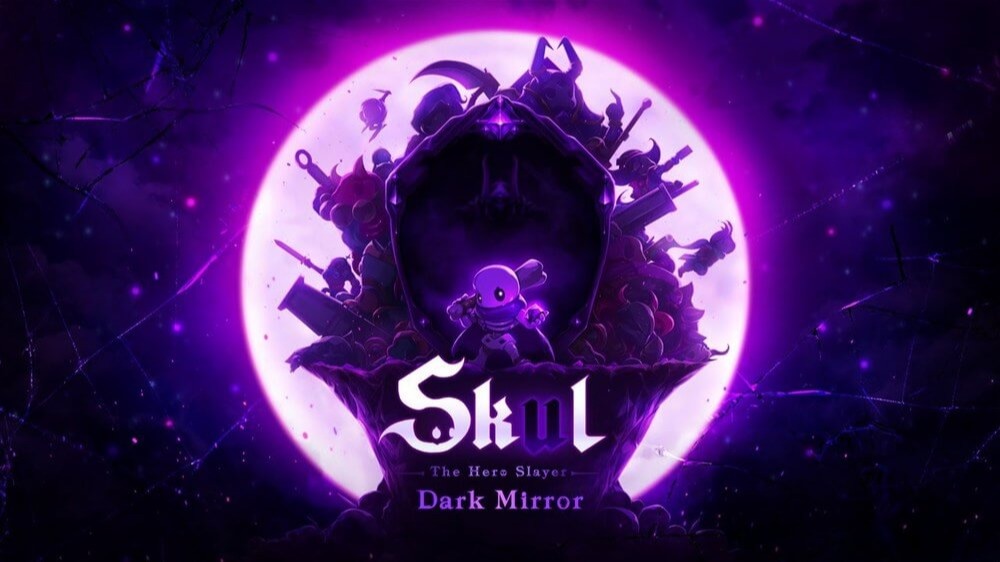
Skul: The Hero Slayer - Another roguelite to the golden collection of the genre
This time, let's start with a little introduction: What makes Roguelike and Roguelte great genres? Games in this genre are often made in two-dimensional pixel art. Often a roguelike is a game where the main character runs from left to right, beats enemies, cleans the same type of rooms, and collects random power-ups. Rarely roguelike are made with an isometric camera from above with simple drawing. Occasionally a roguelike has an outward appearance, but these cases are isolated. The captivating magic of roguelite is in the complexity and depth. There are few prerequisites for Roguelite: permanent death of the protagonist - after the death of the protagonist the savegame is deleted, no checkpoints and choice of levels. All that's left after trying is a handful of currency for meta-progression. Meta progression is background progress, progress on subsequent attempts to complete the game in one go. Roughly speaking: meta progression is a behind-the-scenes boost to the main game. Meta progression is a week of saving up for +50 health points and +40% damage. Gradually the character crosses the line and becomes strong enough to survive. At this point the second layer of Roguelite is revealed - the builds...
Builds and synergies are the cornerstones of the genre. In all roguelike and roguelite levels are built on the principle of procedural generation, so each new attempt to pass the game will be different from the previous one. What items will fall out? Which of them to pay attention to, and which is better not to pick up at all? What bonuses are appropriate and for what style of play? The answers to all these questions come with experience. Uncommonly, when before the race player outlines the ideal warrior, but in the course of passing meets excellent items for a magician - the idea to pump the warrior immediately falls away.
Roguelite - it's a genre about being able to level out the mite of randomness, about the excitement and about variability. Gameplay formula is immutable, but there are many visions: in some roguelite emphasis is placed on the story component, while others bolster the new mechanics with the management of the settlement, which lives its life in real time. Sometimes roguelike takes you into the wilds of role-playing with hundreds of combinations and dozens of tactics. Skul: The Hero Slayer has only one mechanic, but that mechanic allows you to completely change your play style at the touch of a button...
Press "X" to play another game
Skul: The Hero Slayer is a one-chip game. That chip is the interchangeable skulls of the protagonist. You'll play with a skeleton with the uncomplicated name Skul. Skal is able to remove and put on skulls. Depending on the choice of skull, Skal can be a nimble but skinny scout, slow but burly tank or go to the balance - to put on a skull with an intermediate accent. The division is relative, in all three classes there are exceptions. You can wear up to two skulls at the same time, and at any time style of play can be switched. The directionality of many skulls is sometimes not obvious. There are not many archetypal "warriors" or "brigands," there are many exotics. For example: the player may stumble upon an obscure purpose skull, a metal skull, and accidentally rock the mounds of enemies.
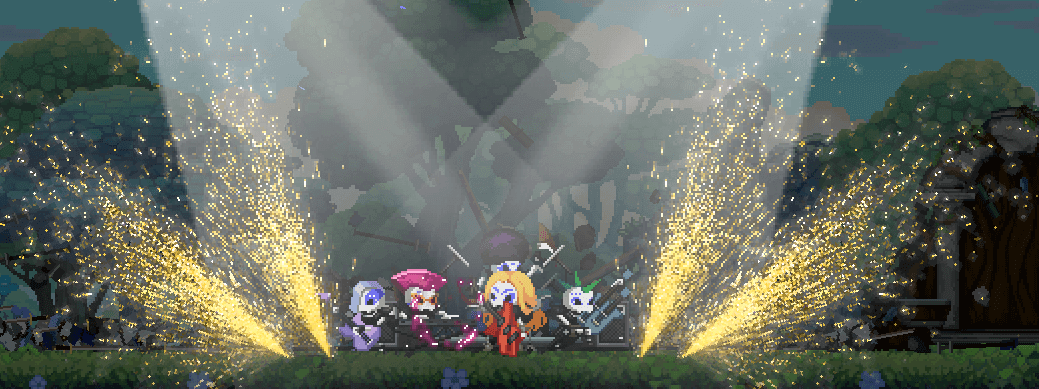
Skulls are divided into rarities: common, rare, unique and legendary. As a rule, skulls have by default two active abilities and one passive one. "Default" - because each skull has many more abilities than the two originally proposed... Yes and some skulls have three active abilities, but about that later... And even those abilities that are there from the beginning of the race can get new properties. For example: the Thief skull's rolled smoke grenade not only does damage, but also places traps on the ground. And that's just the active abilities...
Passive abilities are a separate story. No "+50% to armor" in the Warrior, all the passive abilities cleverly play around with the skull, highlight its uniqueness, and sometimes even add to the game a new variable: the Wizard consumes mana, the Fighter, the bony version of Monk from Diablo III, the power affects the punch counter, some skulls can fly ... In Skul: The Hero Slayer over fifty skulls, and most of them do not like each other ...
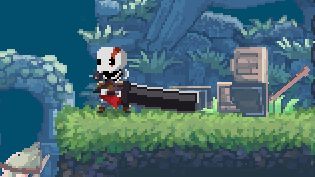
Skul: The Hero Slayer is sucking the player deeper and deeper into itself while skulls of all sorts fall out of the horn of plenty. Once the variety of skulls is exhausted, you immediately remember that even from the simple skulls you can mold something interesting. Rare skulls initially fall in a better quality than the usual, and unique - better quality than the rare. Upgrading a skull to the next stage changes how the active abilities work and enhances the passive ones. So the aforementioned Thief skull turns into a lightning assassin with evasions, critical hits from the back, coupled with the passive ability to knock out of the enemies extra gold to buy vital items. It's unclear why, but many of the skulls work similarly to the heroes from Dota 2: there is a local Monkey King, and Undying, and the menace of the middle line - His Majesty Pudge. Of course, all these skulls have different names, but playing Dota in rogue-lite mode is something new.
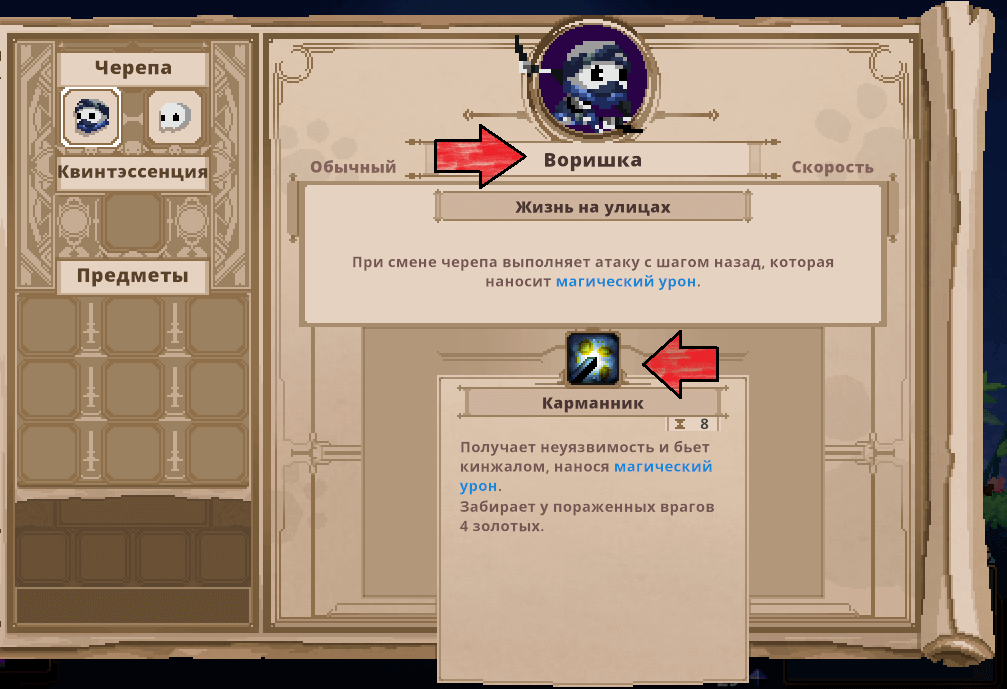
Skul: The Hero Slayer is pure roguelite: the game is divided into stages with no saves or respawns. In each stage, rooms are randomly generated. Along the way, in addition to the usual rooms with enemies, you may come across rooms with side quests, and a treasure trove with a huge chest and a dozen smaller chests. The smaller chests contain gold and hidden traps, but only one chest holds the radiant key... to that very huge chest. There is always something very valuable lurking in a huge chest. Now imagine that in that chest is a legendary skull, which will completely change the plans for the game. And such an outcome in Skul: The Hero Slayer is not uncommon - it's the case when you're lucky. Unlucky - when the God of randomness is not on the side of the player: an adequate alternative to the initial skull does not fall out, and the locations do not meet the necessary activities.
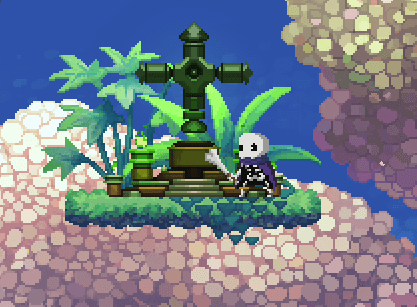
In this kaleidoscope of randomness, on the verge between euphoria and depression, hours pass in Skul: The Hero Slayer. The joy is brought by the variety, the necessary items on sale and the discovery of new ways to implement skulls. What depresses is the initial skull. It's so lousy that some players will cut off immediately. But what hurts the most is the fact that it's almost impossible to get through the game without the right activities, and that not all skulls, no matter how invested in them, will be equally effective. No matter how much the developers from SouthPAW Games try to adjust the balance, no matter how many patches they release, the obvious bias is felt. Get through the game on a deliberately weak skull is possible, but for such efforts achievements are not allowed. Small things, but unpleasant. The second problem is Skul: The Hero Slayer: it is possible to break the balance in this roguelite. There is a completely unbalanced skull in this game. He takes out the entire map at the press of a button, kills bosses in 4-6 presses. I will not tell you the name of this skull, because all the other skulls pale in comparison. But for fans of destroying the entire map I'll give you a little hint: this skull refers to the universe of World of WarCraft.
What do you do when you're tired of juggling skulls?
The skull-changing thing is the main one. But in the secret pocket of Skul: The Hero Slayer there are still some curious things hidden. Yes, the game is made according to the classic formula of gameplay, and apart from the game with skulls you won't find anything more revolutionary in it. The same shops with merchants that sell random items...
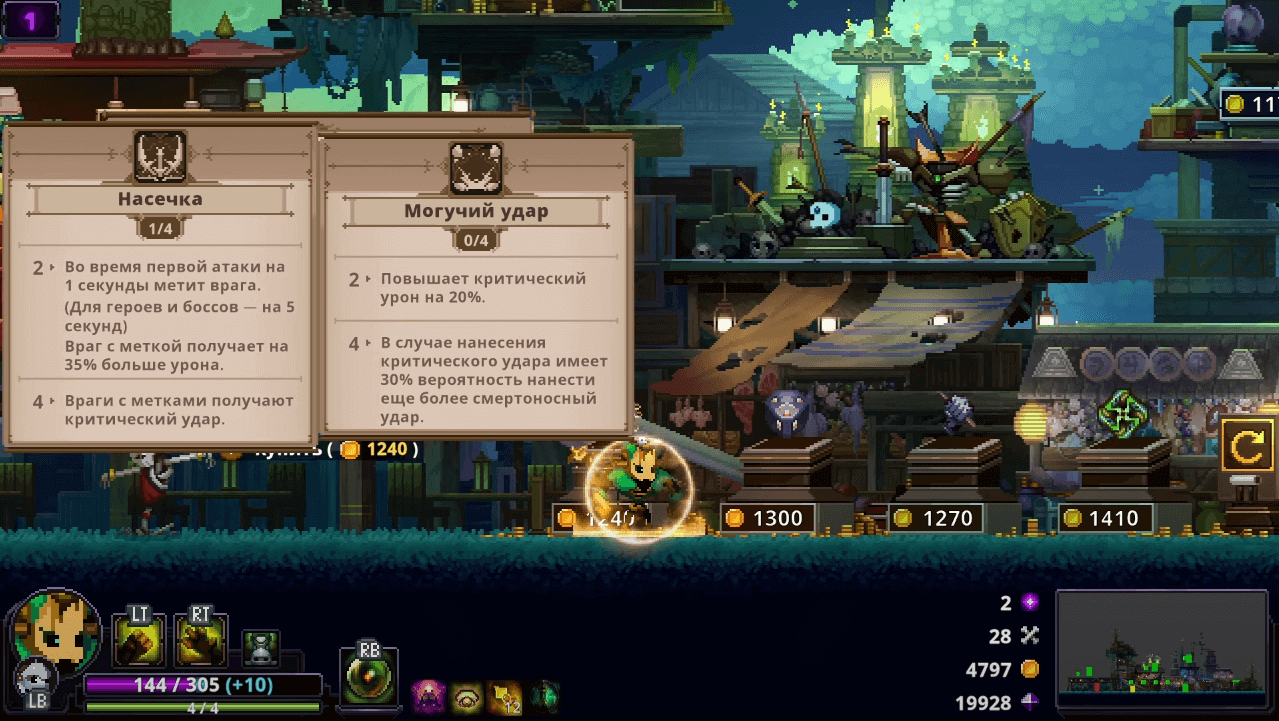
...Same meta progression. The classic ridiculous bonuses a la "+2% physical damage" for each level you pump. The same behind-the-scenes progression, where for an impressive supply of resources they offer to lighten the next runs...
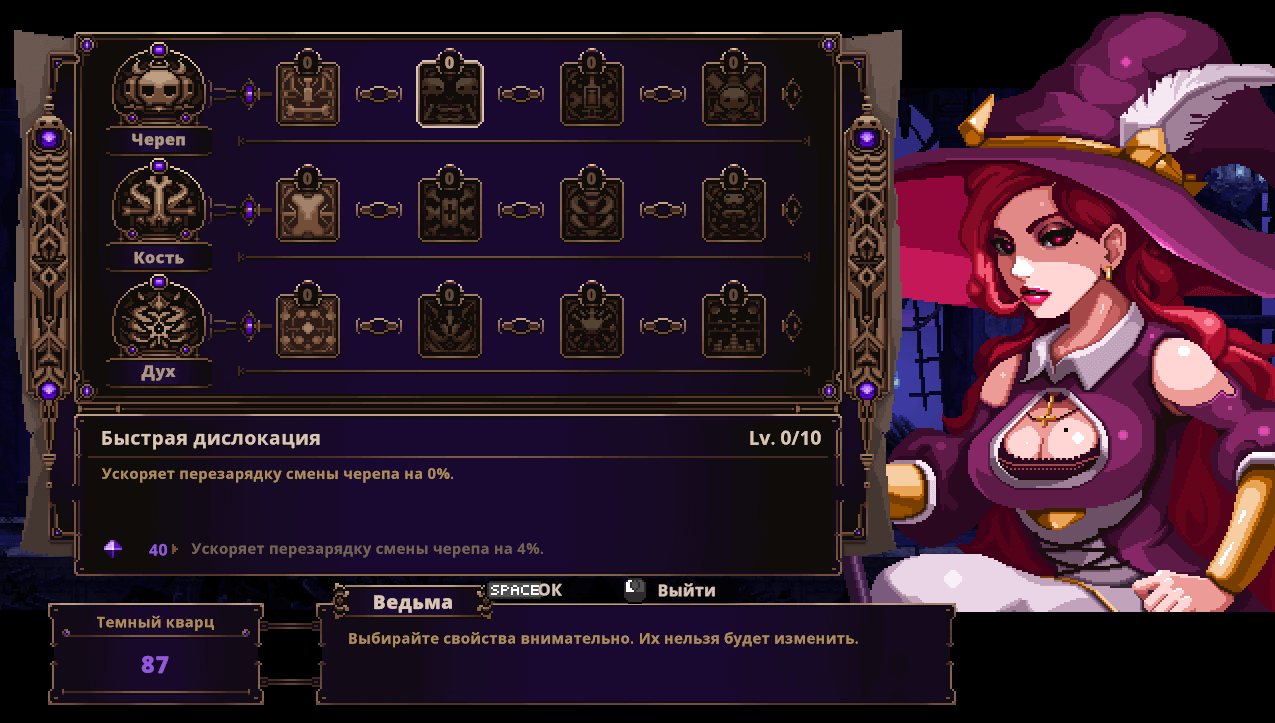
There's nothing behind the scenes of Skul: The Hero Slayer that any fan of the genre hasn't seen in other projects. There's no place for thoughtful hubbub. Prefer to compare sword specs with a calculator? Going into your next run with a rigorous mathematical calculation? Then Skul: The Hero Slayer isn't your game. Here you have seconds to think: who to attack first, how to move, which of the dropped items is more important...
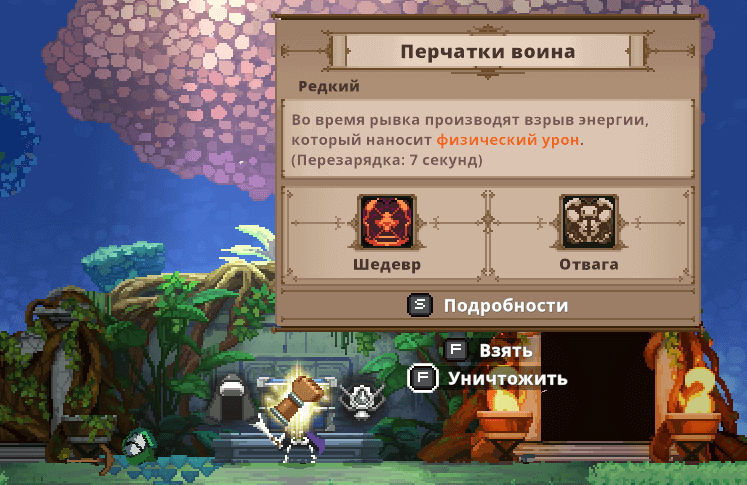
But it is in the items that lurks the second most important mechanic of Skul: The Hero Slayer: items are divided into sets and give bonuses if you wear several things from the set. There is a similar mechanic in Witcher III, where the player was motivated not to put things on, judging only by characteristics, but consciously strive for synergy between things. Except that in Witcher III, the player does not risk hanging around for weeks in search of the right things that are not useful to him in the end. And in Skul: The Hero Slayer such a situation is not uncommon.
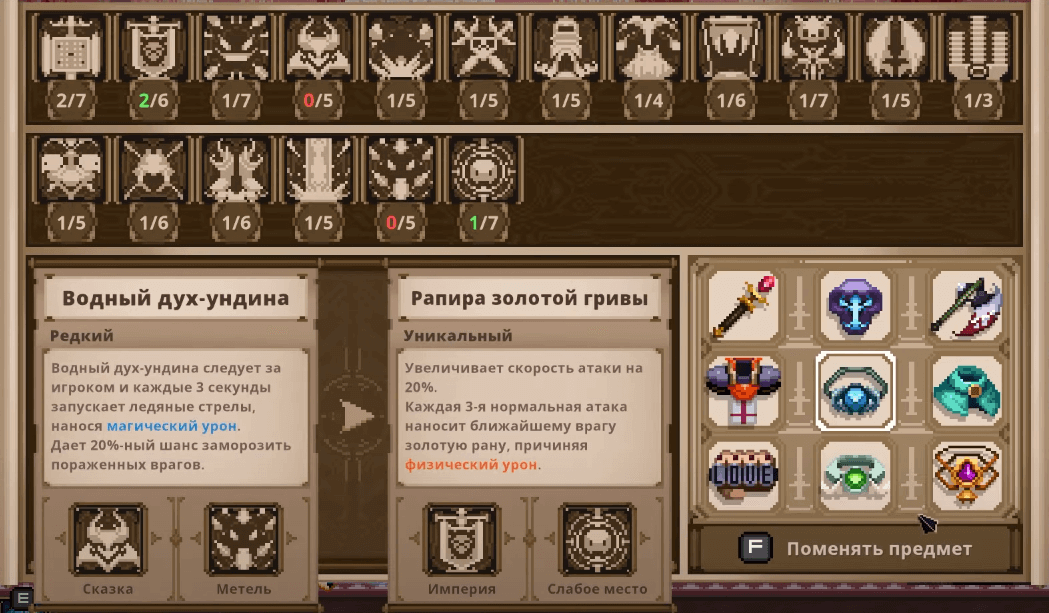
I have to hand it to the game: there are a lot of armor sets, and it's interesting to collect them. However, you can't pass the game with interesting items, only with effective ones. The same goes for quintessences, which are additional replaceable active abilities. There is a choice between quintessences as it were, they all work differently: some turn the Rock into an invulnerable slug, others heal. There's even a Chinese knockoff of Hand of Midas from Dota 2 from the expanses of AliExpress... But the closer you get to the finale, the smaller the list of useful quintessences. Ruguelite suffers from the ailment: the game even offers dozens of options to choose from, but over time most of the items become useless, and good things have no alternatives. Skul: The Hero Slayer suffers from the same ailment, however...
Is Skul: The Hero Slayer worth buying?
Despite the fact that Skul: The Hero Slayer has no thoughtful builds and hundreds of hours of replayability, the game has already made it to the golden roguelike collection. Skul: The Hero Slayer is a game on the level of Darkest Dungeon, Katana Zero, Enter the Gungeon, Hades, Curse of the Dead Gods. But still an order of magnitude less significant than Dead Cells. If the names of all these games don't mean anything to you, you have heard something about roguelikes, but you are scared of the genre's extreme difficulty - Skul: The Hero Slayer is a perfect springboard for you with a moderate level of difficulty. If you are a roguelike veteran, and you think that you can't be surprised by anything, then let me rejoice: skul mechanics won't give you hundreds of hours of variant gameplay, but it guarantees a nice role-playing attraction.
